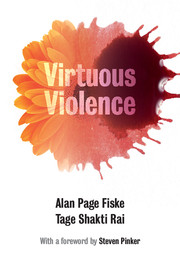Book contents
- Frontmatter
- Dedication
- Contents
- Figures and tables
- Foreword
- Warm thanks
- The point
- 1 Why are people violent?
- 2 Violence is morally motivated to regulate social relationships
- 3 Defense, punishment, and vengeance
- 4 The right and obligation of parents, police, kings, and gods to violently enforce their authority
- 5 Contests of violence: fighting for respect and solidarity
- 6 Honor and shame
- 7 War
- 8 Violence to obey, honor, and connect with the gods
- 9 On relational morality: what are its boundaries, what guides it, and how is it computed?
- 10 The prevailing wisdom
- 11 Intimate partner violence
- 12 Rape
- 13 Making them one with us: initiation, clitoridectomy, infibulation, circumcision, and castration
- 14 Torture
- 15 Homicide: he had it coming
- 16 Ethnic violence and genocide
- Chapter 17 Self-harm and suicide
- 18 Violent bereavement
- 19 Non-bodily violence: robbery
- 20 The specific form of violence for constituting each relational model
- 21 Why do people use violence to constitute their social relationships, rather than using some other medium?
- 22 Metarelational models that inhibit or provide alternatives to violence
- 23 How do we end violence?
- 24 Evolutionary, philosophical, legal, psychological, and research implications
- The dénouement
- References
- Index
23 - How do we end violence?
Published online by Cambridge University Press: 05 December 2014
- Frontmatter
- Dedication
- Contents
- Figures and tables
- Foreword
- Warm thanks
- The point
- 1 Why are people violent?
- 2 Violence is morally motivated to regulate social relationships
- 3 Defense, punishment, and vengeance
- 4 The right and obligation of parents, police, kings, and gods to violently enforce their authority
- 5 Contests of violence: fighting for respect and solidarity
- 6 Honor and shame
- 7 War
- 8 Violence to obey, honor, and connect with the gods
- 9 On relational morality: what are its boundaries, what guides it, and how is it computed?
- 10 The prevailing wisdom
- 11 Intimate partner violence
- 12 Rape
- 13 Making them one with us: initiation, clitoridectomy, infibulation, circumcision, and castration
- 14 Torture
- 15 Homicide: he had it coming
- 16 Ethnic violence and genocide
- Chapter 17 Self-harm and suicide
- 18 Violent bereavement
- 19 Non-bodily violence: robbery
- 20 The specific form of violence for constituting each relational model
- 21 Why do people use violence to constitute their social relationships, rather than using some other medium?
- 22 Metarelational models that inhibit or provide alternatives to violence
- 23 How do we end violence?
- 24 Evolutionary, philosophical, legal, psychological, and research implications
- The dénouement
- References
- Index
Summary
Empirically, as we have seen in chapter after chapter, the objective fact is that people are sometimes morally motivated to harm or kill. Sometimes people feel that to be good, to be just, to be honorable, to do their duty, they have to hurt someone. Morality consists of regulating social relationships (Rai and Fiske, 2011, 2012), and the inductively assembled evidence shows that sometimes moral motives impel people to regulate critical relationships violently. This reveals how profoundly important social relationships are: people will sometimes kill or die to make their relationships right. People’s relationships sometimes are more important to them than their bodies or their very lives, and sometimes to make their relationships right, people sacrifice the bodies or the lives of their spouses, children, friends, neighbors, or others.
Thus, the essential message of virtuous violence theory is that we cannot attribute most violence to the “breakdown” of morals, or to individualistic rational actors amorally maximizing their personal asocial utility functions. The obverse message is that we cannot equate morality with just gentleness, compassion, caring, or harm-avoidance: there are moralities that impel to violence. Meritorious performance of one’s moral duty may consist of kindness or killing.
From these facts there are three conclusions that we cannot draw. These facts do not imply that a person cannot help but constitute relationships violently.
- Type
- Chapter
- Information
- Virtuous ViolenceHurting and Killing to Create, Sustain, End, and Honor Social Relationships, pp. 276 - 286Publisher: Cambridge University PressPrint publication year: 2014
- 3
- Cited by



